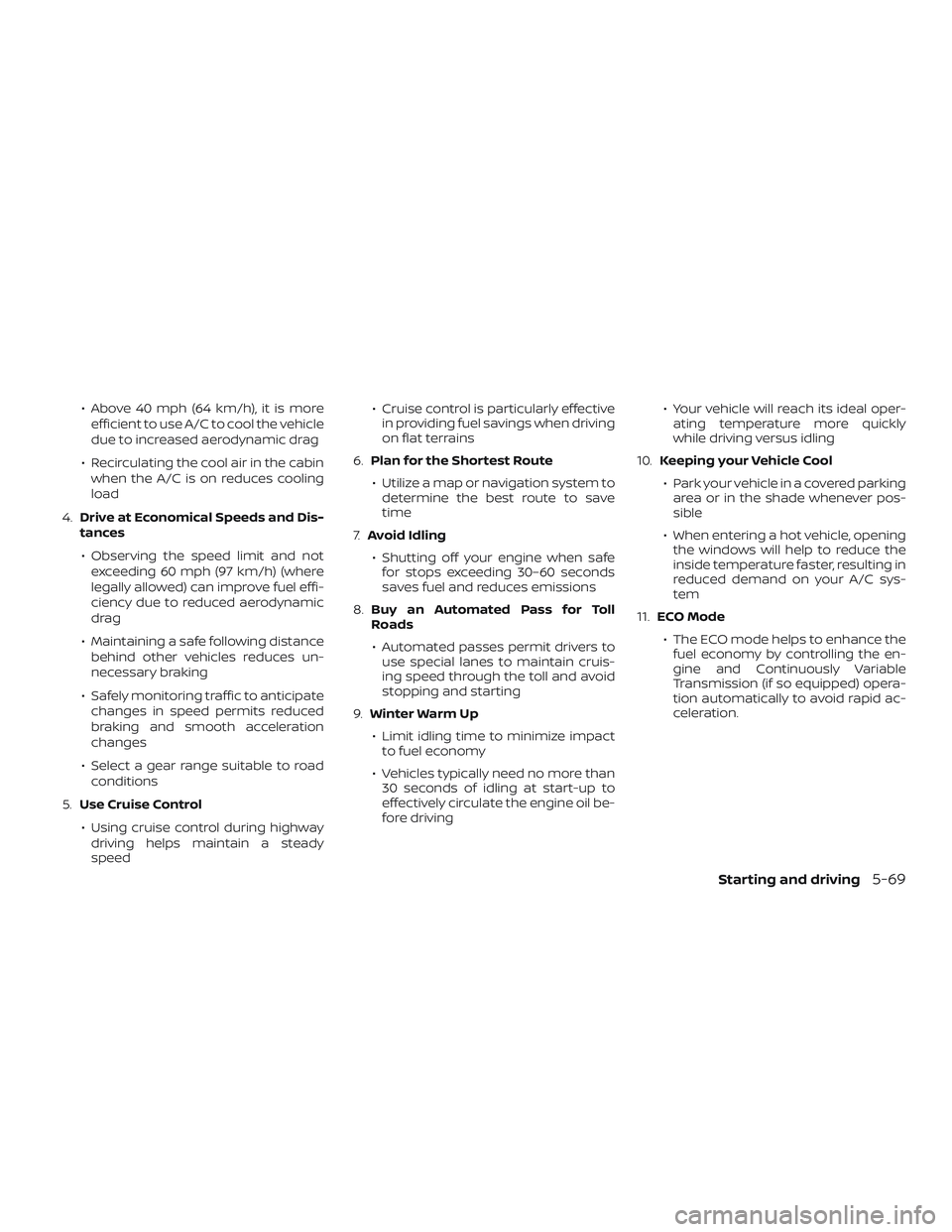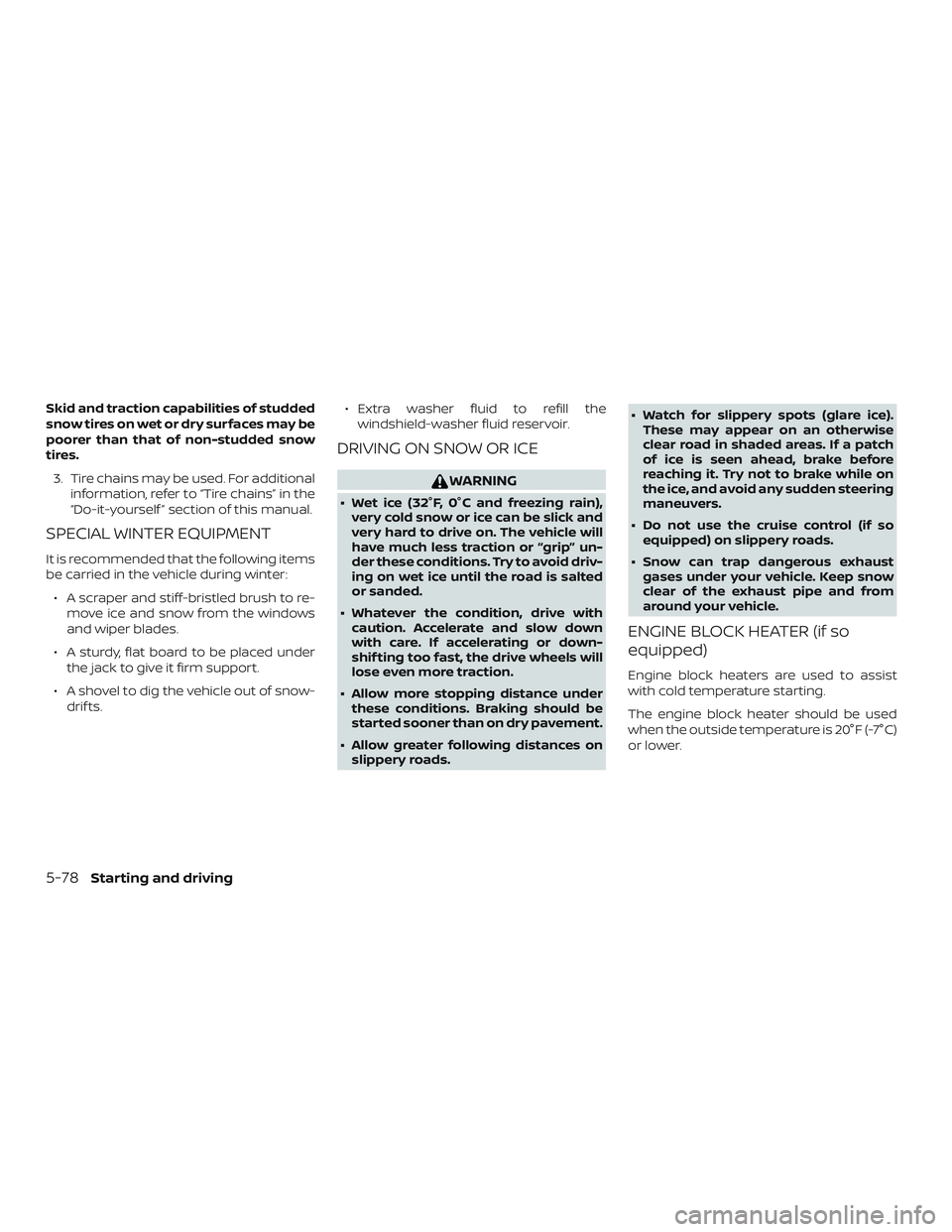2018 NISSAN SENTRA cruise control
[x] Cancel search: cruise controlPage 375 of 507

∙ Above 40 mph (64 km/h), it is moreefficient to use A/C to cool the vehicle
due to increased aerodynamic drag
∙ Recirculating the cool air in the cabin when the A/C is on reduces cooling
load
4. Drive at Economical Speeds and Dis-
tances
∙ Observing the speed limit and not exceeding 60 mph (97 km/h) (where
legally allowed) can improve fuel effi-
ciency due to reduced aerodynamic
drag
∙ Maintaining a safe following distance behind other vehicles reduces un-
necessary braking
∙ Safely monitoring traffic to anticipate changes in speed permits reduced
braking and smooth acceleration
changes
∙ Select a gear range suitable to road conditions
5. Use Cruise Control
∙ Using cruise control during highway driving helps maintain a steady
speed ∙ Cruise control is particularly effective
in providing fuel savings when driving
on flat terrains
6. Plan for the Shortest Route
∙ Utilize a map or navigation system to determine the best route to save
time
7. Avoid Idling
∙ Shutting off your engine when safe for stops exceeding 30–60 seconds
saves fuel and reduces emissions
8. Buy an Automated Pass for Toll
Roads
∙ Automated passes permit drivers to use special lanes to maintain cruis-
ing speed through the toll and avoid
stopping and starting
9. Winter Warm Up
∙ Limit idling time to minimize impact to fuel economy
∙ Vehicles typically need no more than 30 seconds of idling at start-up to
effectively circulate the engine oil be-
fore driving ∙ Your vehicle will reach its ideal oper-
ating temperature more quickly
while driving versus idling
10. Keeping your Vehicle Cool
∙ Park your vehicle in a covered parking area or in the shade whenever pos-
sible
∙ When entering a hot vehicle, opening the windows will help to reduce the
inside temperature faster, resulting in
reduced demand on your A/C sys-
tem
11. ECO Mode
∙ The ECO mode helps to enhance the fuel economy by controlling the en-
gine and Continuously Variable
Transmission (if so equipped) opera-
tion automatically to avoid rapid ac-
celeration.
Starting and driving5-69
Page 384 of 507

Skid and traction capabilities of studded
snow tires on wet or dry surfaces may be
poorer than that of non-studded snow
tires.3. Tire chains may be used. For additional information, refer to “Tire chains” in the
“Do-it-yourself ” section of this manual.
SPECIAL WINTER EQUIPMENT
It is recommended that the following items
be carried in the vehicle during winter:
∙ A scraper and stiff-bristled brush to re- move ice and snow from the windows
and wiper blades.
∙ A sturdy, flat board to be placed under the jack to give it firm support.
∙ A shovel to dig the vehicle out of snow- drif ts. ∙ Extra washer fluid to refill the
windshield-washer fluid reservoir.
DRIVING ON SNOW OR ICE
WARNING
∙ Wet ice (32°F, 0°C and freezing rain),very cold snow or ice can be slick and
very hard to drive on. The vehicle will
have much less traction or “grip” un-
der these conditions. Try to avoid driv-
ing on wet ice until the road is salted
or sanded.
∙ Whatever the condition, drive with caution. Accelerate and slow down
with care. If accelerating or down-
shif ting too fast, the drive wheels will
lose even more traction.
∙ Allow more stopping distance under these conditions. Braking should be
started sooner than on dry pavement.
∙ Allow greater following distances on slippery roads. ∙ Watch for slippery spots (glare ice).
These may appear on an otherwise
clear road in shaded areas. If a patch
of ice is seen ahead, brake before
reaching it. Try not to brake while on
the ice, and avoid any sudden steering
maneuvers.
∙ Do not use the cruise control (if so equipped) on slippery roads.
∙ Snow can trap dangerous exhaust gases under your vehicle. Keep snow
clear of the exhaust pipe and from
around your vehicle.
ENGINE BLOCK HEATER (if so
equipped)
Engine block heaters are used to assist
with cold temperature starting.
The engine block heater should be used
when the outside temperature is 20°F (-7°C)
or lower.
5-78Starting and driving
Page 498 of 507

Brakewarninglight............2-14
Brakewearindicators.......2-22,8-21
Self-adjustingbrakes...........8-21
Brakeandclutchfluid.............8-12
Brake assist ...................5-74
Brakefluid....................8-12
Brakes......................8-21
Brake system ..................5-72
Break-in schedule ...............5-68
Brightness/contrast button .........4-9
Brightness control Instrument panel .............2-45
Bulb check/instrument panel ........2-14
Bulb replacement ...............8-33
C
Capacities and recommended fuel/
lubricants....................10-2
Cargo
(See vehicle loading information) .....10-14
Car phone or CB radio ............4-79
CDcareandcleaning.............4-71
CD player
(See audio system) ........4-46,4-51,4-58
Check tire press .................2-6
Check tire pressure ..............2-34
Childrestraints........1-21, 1-22, 1-23, 1-26 LATCH (Lower Anchors and Tethers for
CHildren)System..............1-26
Precautions on child
restraints .........1-23, 1-30, 1-36, 1-41
Top tether strap anchor point
locations.................. .1-28
Child safety rear door lock ..........3-7Chimes, audible reminders
.........2-22
Cleaningexteriorandinterior......7-2,7-4
Clock
(models without navigation system). .4-50
Clockset ....................4-50
Clock set/adjustment .............4-7
Clock setting (models with Navigation
System)......................4-7
Clock setting (models without Navigation
System)...........4-44,4-45,4-49,4-50
Clutch Clutchfluid.................8-12
C.M.V.S.S. certification label .........10-12
Cold weather driving .............5-77
Compact disc (CD) player . . .4-46, 4-51, 4-58
Connect phone ................4-74
Console box ..................2-53
Console light ..................2-61
Continuously Variable Transmission
(CVT) .....................5-9,5-17
Continuously Variable Transmission
(CVT) fluid ..................8-11
Driving with Continuously Variable
Transmission (CVT) ..........5-9,5-17
Control panel buttons .............4-4
Back button .................4-7
Brightness/contrast button .......4-9
Enterbutton.................4-4
Settingbutton................4-7
Controls Audio controls (steering wheel) .....4-72
Heater and air conditioner
controls................4-24,4-32
Coolant Capacities and recommended
fuel/lubricants...............10-2 Changing engine coolant
.........8-6
Checking engine coolant level ......8-6
Engine coolant temperature gauge. . .2-7
Corrosionprotection..............7-8
Cruisecontrol.................5-45
Cupholders...................2-55
Curtain side-impact air bag system
(See supplemental side air bag and curtain
side-impact air bag system) ........1-59
D
Daytime Running Light System ......2-44
Defroster switch Rear window and outside mirror
defrosterswitch..............2-40
Dimensions and weights ..........10-10
Dimmer switch for instrument panel . . .2-45
Display controls
(see control panel buttons) ..........4-4
Door locks ....................3-5
Door open warning light ...........2-15
Drivebelt ....................8-16
Driving Coldweatherdriving...........5-77
Driving with Continuously Variable
Transmission (CVT) ..........5-9,5-17
Driving with manual
transmission .............5-10,5-23
Precautions when starting and
driving .....................5-2
Driving the vehicle ...............5-17
11-2
Page 500 of 507

Heated seat switches.............2-47
Heater Heater and air conditioner (automatic)
(if so equipped) ...............4-31
Heater and air conditioner
controls................4-24,4-32
Heater and air conditioner
(manual) ...................4-23
Heater operation ....4-17,4-19,4-25,4-33
Heater and air conditioner (automatic) . .4-31
HomeLink® Universal
Transceiver . .2-63, 2-64, 2-65, 2-66, 2-66, 2-67
Hood .......................3-25
Horn.......................2-47
I
Ignition switch ..................5-9
Push-button ignition switch .......5-11
Immobilizer system ........2-38,5-11, 5-14
Important vehicle information label . . .10-12
In-cabinmicrofilter ..............8-19
Increasing fuel economy ...........5-70
Indicator NISSAN Intelligent Key® battery discharge
indicator...................5-13
Indicator lights and audible reminders
(See warning/indicator lights and audible
reminders) .................2-19,3-21
Inside automatic anti-glare mirror .....3-32
Instrument brightness control .......2-45
Instrument panel .............0-6,2-2
Instrument panel dimmer switch .....2-45Intelligent cruise control (ICC) system
Brake assist .................5-47
Intelligent Key system Key operating range ............3-13
Key operation ................3-14
Mechanical key ...............3-4
Remote keyless entry operation . .3-9, 3-18
Troubleshooting guide .......3-23,3-24
Warning signals ...........3-23,3-24
Interiorlight...............2-60,2-62
Interiortrunklidrelease...........3-26
iPod®Player...............4-63,4-66
ISOFIX child restraints .............1-26
J
Jumpstarting...............6-9,8-15
K
Key.........................3-2
Key fob battery replacement .....8-25,8-26
Keyless entry With Intelligent Key system
(See Intelligent Key system) .....3-9,3-18
Without Intelligent Key system
(See remote keyless entry system) . . .3-8
Keys NISSAN Intelligent Key® ........3-2,3-11
NISSAN Vehicle Immobilizer System
keys......................3-4 L
Labels Air conditioner specification label . . .10-13
C.M.V.S.S. certification label .......10-12
Emission control information label . .10-12
Engine serial number ..........10-12
F.M.V.S.S. certification label .......10-12
Tire and Loading Information label . .10-13
Vehicle identification number (VIN) . .10-11
Vehicle identification number (VIN)
plate.....................10-11
Warning labels (for SRS) ..........1-62
LATCH (Lower Anchors and Tethers for
CHildren)System................1-26
License plate Installing the license plate .......10-13
Light Airbagwarninglight........1-63, 2-19
Brakelight(Seestoplight)........8-33
Bulb check/instrument panel ......2-14
Bulb replacement .............8-33
Charge warning light ...........2-15
Console light ................2-61
ExteriorandInteriorlights........8-33
Foglights..................8-31
Foglightswitch..............2-46
Headlight and turn signal switch ....2-41
Headlightcontrolswitch.........2-41
Headlights .................8-29
Interiorlight.............2-60,2-62
Lightbulbs.................8-29
Low tire pressure warning light .....2-16
Low windshield-washer fluid warning
light ..................2-18,2-34
11-4